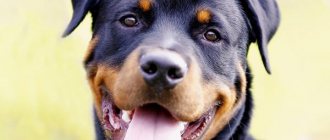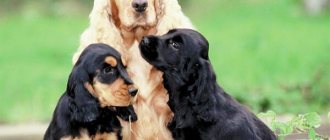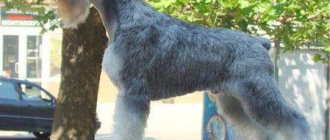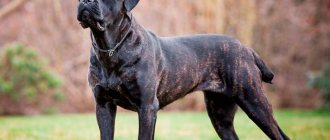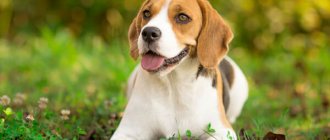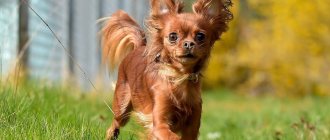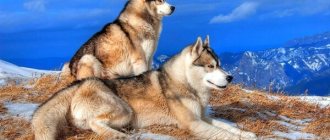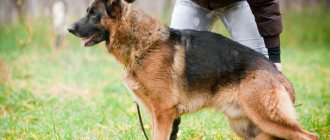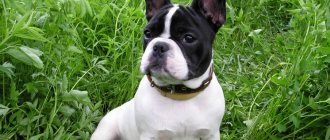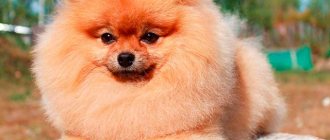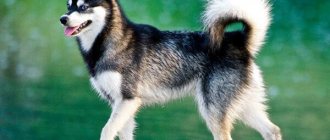In addition to their delightful appearance, Samoyeds are distinguished by their sharp mind, love of people, and calm and obedient character.
They can rightfully be proud of the ancient history of the sled dog breed, which originated in the north of Russia.
These beauties have always been man's helper and friend, they went hunting with their owner, acted as nannies for children and herded deer herds.
Samoyed dog Laika: characteristics and description of the breed
This breed is one of the most ancient. It is believed that it appeared more than 3,000 years ago in Siberia and the Far North of Russia, and belongs to the Spitz group. And such dogs were brought to Europe around the end of the 19th century. It is noteworthy that in Russia this breed was considered almost extinct, and was again brought into the country only in the 90s of the last century. According to the international classification, this breed is classified as aboriginal, or primitive, since it was practically not subjected to the intervention of breeders.
There are several names used for dogs of this breed:
- Sami husky
- arctic spitz
- samoyed husky
- Samoyed
- Samoyed dog
Samoyed dog Laika
For many centuries, the Samoyed dog has been a reliable companion for the northern peoples. People used these animals in many ways:
- while hunting seals and walruses.
- as shepherds for grazing herds of reindeer.
- for warmth - often people slept with dogs in the chum in an embrace, clinging tightly to them. At the same time, Samoyeds freeze, becoming extremely careful and attentive, and try not to disturb their person as the guardian of their property.
- as a reliable nanny for a child in the absence of parents.
- for sled riding - experts have differing opinions on this issue. Some researchers argue that Nenets culture prohibited the use of such dogs as draft force. Others say that carrying heavy loads is the main function of Samoyed dogs.
- for forwarding support of goods.
The appearance of the Samoyed dog leaves no one indifferent. Snow-white fluffy fur and a good-natured expression on the face (thanks to the characteristic “smile” and slightly sly eyes) always attract attention to this animal.
Samoyed husky
In addition, breeders claim that this breed has an extremely pleasant character. Indeed, over their thousand-year history, Sami huskies have always been in close contact with humans. Therefore, they have developed a subtle understanding of people and a strong attachment to them.
Distinctive character traits of the Samoyed dog:
- extremely friendly and affectionate - this animal can find an approach to any family member.
- loving - always tries to please her master, although sometimes she can be stubborn.
- gets along well with other animals in the house - due to evolution, Samoyeds have practically lost their hunting instincts, so they get along well with other domestic animals.
- is a full member of the family who takes an active part in all matters and events.
- loves children very much and patiently endures their increased (and sometimes intrusive) attention to her person.
- This animal is devoted to only one owner and his family. Therefore, it is not recommended to adopt a dog as an adult.
- very smart and quick-witted (even cunning), understanding her owner well.
- completely devoid of aggressiveness. This kind of husky rarely starts a fight, but at the same time it can stand up for itself.
- cheerful and mischievous - in America, Samoyeds are often called mood-lifting dogs and are recommended for those who feel lonely or are prone to frequent depression.
Samoyed
- Absolutely cannot stand loneliness. A Samoyed should not be locked in an apartment alone. He is always drawn to people and constantly demands attention. It will be better if at least one family member is always present at home. When this dog is left alone even for a short time, it begins to get nervous and chew everything around. People who are too busy and are rarely at home are advised to get other breeds.
- loves physical contact with a person, loves to jump near him, expressing his joy and demanding affection.
- very energetic and active - for normal development she needs space and active walks in the fresh air.
- This breed is adapted to live in nature. Therefore, small enclosed spaces or kennels are not suitable for the animal. It is preferable to build a spacious enclosure for her in the courtyard of a private house.
- endowed with a calm and independent character, sometimes turning into stubbornness.
- strong and resilient, with a special flair. Her ancestors always found their way home, and also sensed cracks in the ice even under deep snow.
- is highly social. Samoyeds are sociable not only with members of their family, but also with strangers. Therefore, this breed is not entirely suitable for protection.
- unpretentious and extremely hardy.
- curious, full of enthusiasm, absolutely not shy and playful until old age.
- A rather talkative dog who loves the sound of his voice and therefore often gives it.
- Samoyeds' favorite time of year is winter.
Good or evil?
There is no need to doubt this issue. Samoyeds are certainly one of the most good-natured and loving dog breeds.
Representatives of the breed have lived side by side with people since ancient times, helped them in everything, and constantly showed devotion and respect.
An excellent proof of a dog's kindness and calm nature is its love for children. They tolerate the prolonged attention of even the smallest children to themselves without any aggression, and are ready to play with them for hours.
They also get along well with other pets, including felines.
Why is the Samoyed husky called that?
Many people are interested in where such a strange, and even slightly ominous name for the breed “Samoyed Laika” came from. There are two main versions of the origin of this name.
Generally recognized (official):
Such animals were bred by northern peoples belonging to the Samoyed group (Nenets, Enets, Selkups, Laplanders). In the old days they were called “samoyed”, “self-integrated” - that is, “those who live separately, on their own, alone.” And the dogs that belonged to them began to be called the same by analogy.
Samoyed in winter
Without any scientific confirmation (unofficial):
When the snow-white Samoyeds were harnessed to a sled, they were not noticeable at all against the background of snow. And the impression was created that the sleigh moved without outside help. And for this reason, such sleds were called “self-eating”, or otherwise “samoyeds”. Subsequently, the dogs themselves began to be called this way.
What to do with your dog?
Natural endurance, intelligence and agility make this breed suitable for various sports and training. In their reviews of Samoyeds, owners note their ability for domestic obedience.
The dogs work well in harness and are able to travel long distances in harsh weather conditions. True, their speed is low, but the Samoyed team looks great against the backdrop of the snow cover.
Among other sports, owners prefer:
- Frisbee;
- freestyle;
- agility;
- canicross and skijoring;
- flyball;
Samoyed dog Laika - breed standard: size and weight of an adult dog
The generally accepted breed standards for the Samoyed Laika include the following external characteristics:
- the average weight of the animal is from 23 to 30 kg
- height at the withers - from 57 to 60 cm for males, and from 53 to 56 cm for females (in the English standard, male - from 51 to 56 cm, female - from 46 to 51 cm, and in American - from 53 to 60 cm and from 48 to 53 cm respectively)
- females are slightly smaller in size and outwardly look much more elegant and graceful than males; a fairly powerful head, wedge-shaped, with a slightly convex skull, and towards the nose the evenly tapering length of the muzzle should be approximately equal to the length of the skull
- small triangular, very mobile erect ears. The distance between them is wide. Puppies up to a month old have floppy ears.
- deep-set dark chocolate eyes. They are slightly slanted, almond-shaped and outlined with a dark edging.
Characteristics of the Samoyed
- The nose has a well-developed black lobe. At the age of up to two months, the very strong jaw and strong dental apparatus may not be fully pigmented
- lips black, tightly fitting. At the same time, the corners of the mouth are slightly curved, and thereby form a “smile” characteristic of this breed.
- slightly elongated, strong, extremely muscular body with a strong neck. Moreover, it should be approximately 5% longer than the height of the dog at the withers.
- well-spaced straight muscular parallel limbs, elbows pressed to the body. The dewclaws of puppies are removed at 3-4 days from birth.
- the chest has a width slightly less than half the height of the animal at the withers
- movable long tail, which is set quite high. In an excited state, the Samoyed's tail is bent up or to the side, and in a calm state it is lowered down.
- movements are characterized by a tireless, energetic and free gait
- coat color – white, cream, white and fawn. The tips of the guard hairs have a silvery tint.
Samoyeds have a thick coat.
The main distinguishing feature of the Arctic Spitz is the “polar”, unusually thick coat, which has the following properties :
- The coat itself is double, consisting of a thick, soft but dense undercoat and straight, very long, outer coat.
- the shoulders and neck are framed by an extremely fluffy collar
- the tail is very furry
- from the long hair that grows on the back of the thighs, the so-called “pants” are formed
- protective fur grows on the inner surface of the ears and between the toes
- The coat length of males is slightly longer than that of females
- “fur coat” has a sparkling shine
- at low temperatures the coat becomes even fluffier
- has virtually no characteristic “dog” smell
Dogs have disadvantages
Disqualifying disadvantages of the Sami husky include:
- blue or different colored eyes
- soft ears
- pincer rather than scissor bite
- a tail that is twisted into a double helix
- wavy wool
- excessive gracefulness in males or excessive power in females
- atypical behavior: aggressiveness, cowardice, lack of contact
How and where do you choose a puppy?
The main rule when looking for a puppy is to take your time and evaluate your capabilities. There are a large number of nurseries engaged in breeding this breed in Russia and abroad. Approximate order of searching for a puppy:
- study information about the breed in detail;
- visit dog shows (if possible, special breed shows);
- look for information about nurseries;
- determine for yourself which dog kennel you like best by type;
- find reviews about Samoyeds from the selected kennel;
- contact the breeder and arrange a meeting or delivery of the selected puppy.
The nursery must be officially registered. Puppies not born in a kennel are registered through the club. All individuals must have a brand, which is indicated in the metric. Some breeders implant a chip (at the owner's request).
Package of required documents for a puppy:
- Metrics.
This document is exchanged by the owner of the puppy for the pedigree. The metric indicates the breeder's data, the puppy's date of birth, the kennel's brand, the name of the dog and the names of its parents.
- Veterinary passport.
Must contain information about the anthelmintic measures carried out and scheduled vaccinations. A puppy without a single vaccination will not be passed on to new owners.
The purchase and sale agreement is not mandatory, but it is advisable to draw it up by agreeing with the breeder on the terms of maintenance and completion of the transaction.
Raising and training a Samoyed dog
You need to understand that the Samoyed husky is a pack animal that lives according to certain laws. These are very smart animals with an independent character, which can cause disobedience and stubbornness.
Samoyeds understand perfectly well who is boss in the house, and with proper upbringing they respect and obey the owner. In order for the dog to be obedient and not cause problems, you need to show the animal which of you is the leader.
Listen to the advice of dog handlers:
- It is necessary to begin education at an early age, and training after all vaccinations have been completed (about 3 months).
- Give the puppy his own place and teach him not to get in the way.
- demonstrate your leadership immediately. When entering the premises, the owner must enter first, and then the animal. And you need to feed the dog after the whole family has eaten.
- do not forget that execution of commands is mandatory. If a Samoyed does not follow a command 4 times in a row, this can develop into a system, since it absorbs bad habits as quickly as good ones. The dog may feel permissive and become disobedient.
- Immediately reward the animal’s correct behavior with praise.
- Punish the Samoyed only at the moment of the mistake, so that he understands exactly what action he is doing that causes subsequent punishment.
Samoyed training
- It is very important to wean your Samoyed dog from jumping on people at a very early age. Such jumps, in which the puppy tries to lick you on the lips, are at first a way to simply beg for food, but in later life they acquire another meaning - a demonstration of their leadership. To avoid this, when greeting, praise your puppy only when he has all four paws on the floor or is sitting. Don't react to him while he's jumping. And don't let him lick people's faces.
- Remember that physical contact with a person is always pleasant and desirable for the Samoyed breed. Therefore, when you push the dog away with your hand or lightly slap it on the forehead for disobedience, it is regarded as encouragement and encouragement, which can subsequently develop a love for rough games and fun.
- Never hit your dog with a leash as a punishment - this can lead to the dog resisting and refusing to put it on for a walk.
- When walking, keep the Samoyed on a leash, as if it gets carried away, it can chase small animals and run away.
- It is necessary to walk your husky every day, and be sure to give it the opportunity to run around to its heart's content over a wide area. Breeders recommend creating conditions for the Samoyed in which he will be constantly busy. Otherwise, his unspent energy will result in loud barking for no reason or damage to your things.
- In principle, the Arctic Spitz can easily tolerate high temperatures. However, still avoid intense workouts in extreme heat. Move them to the morning or evening.
- It is important not to forget that this northern handsome man has a vulnerable character. Therefore, when training him, assault or shouting is strictly prohibited. The animal will simply avoid you or not obey you at all.
- Please note that the Samoyed relieves stress by chewing everything around it.
- When training, each session should end with praise for the dog. But it must be deserved. If the Samoyed did not try hard enough or did not follow your commands, do not praise him.
Sometimes owners of Samoyed Laikas complain about their stubbornness and even stupidity. However, this behavior is the result of improper upbringing and training of the animal. Samoyeds are extremely intelligent and highly trainable pets. They just need a fairly firm and confident owner.
History of the breed and its purpose
Dogs of this breed have existed for several thousand years. Representatives of the northern peoples of Russia actively used them as sled dogs, hunters, watchmen and nannies for children. Samoyed dogs helped herd the deer.
Four-legged animals were allowed to stay in the yurt. Small children played with them and dogs looked after them. They say that people could sleep with them in their arms to keep warm.
The Samoyed population in Russia was practically lost, but people managed to bring representatives of this species to Europe. Thanks to the successful work of breeders, the breed has survived to this day in its best form. The first dogs were brought to Russia in 1989 from Denmark and subsequently breeding was built on their basis.
The name "Samoyed" comes from the name of the "Samoyed" tribe, who lived in the northern part of Russia. Samoyeds are the old name of the Nenets, which comes from the phrase “saam jedna” (“Land of the Sami”).
Samoyed Laika - hypoallergenic dog: care and maintenance in the apartment
There is an opinion that the Samoyed is a hypoallergenic dog, and its fur does not cause allergies at all, because it is devoid of a specific “dog” smell. However, this opinion is not entirely correct. Allergies can be caused not by the entire breed of dog as a whole, but by a specific animal in a specific person. Therefore, before getting an Arctic Spitz puppy, it is recommended to undergo appropriate tests to check for an allergic reaction.
The Samoyed dog has a luxurious fur coat, which requires some care and effort on the part of the owners. The texture of this dog's coat is similar to angora wool, so it is often used for knitting fur products.
Caring for your husky
The basic rules for caring for the Sami breed in an apartment or private house are to maintain animal hygiene:
- brush your dog at least twice a week
- During molting, the animal must be combed daily. This period lasts about three weeks and occurs once a year in males, and twice in females.
- It is not recommended to cut a dog's hair, because this may slightly change the structure of the animal's coat, which will negatively affect its protective properties from cold and heat. You only need to trim the fur between your toes if it becomes too long.
- When tangles form in the wool, do not cut them off, but carefully sort them out with your hands
- Check your dog's ears regularly for infections or mites. Clean their surface with a cotton pad soaked in a special product.
- Brush your dog's teeth once a week to prevent gum disease
- Experts recommend trimming your nails once a month.
Carry out the procedure for combing Samoyed hair correctly:
- first comb the animal with a brush, removing dirt
- after this, use a slicker brush, carefully combing it down to the undercoat
- separate part of the fur, holding it with one hand against the growth, and with the other hand comb in the direction of growth
- After thorough combing, use a comb to run the comb against the grain to fluff up the undercoat.
Appearance
An elegant, medium-sized dog with a pure white or biscuit coat. The coat is thick and abundant, forming “pants” on the back of the thigh and a collar on the neck. The structure of the coat is double: a thick and soft undercoat plus a long, hard awn. This cover protects the dog from moisture, cold, wind and overheating.
The Samoyed's ears are small, erect, triangular in shape with rounded tips. Thick hair grows inside the ear to prevent cold air from entering.
A striking feature in the appearance of the Samoyed is the famous smile, as Samoyed owners talk about in reviews. This impression is created from the raised corners of the dog’s lips and the kind, cheerful look of the slanting brown eyes.
The Samoyed's tail is covered with long hair and curls into a ring on the back. Sometimes he rolls over on his back and hangs to his side. In a calm state, it can be lowered to the level of the hock joint.
The limbs are muscular and straight. Movements are energetic and free. Thick hair grows between the toes, which, like felt boots, protects the paw pads from cold and damage. The dog gives the impression of being tireless and powerful, perky and playful, capable of working in a harness in harsh weather conditions.
What to feed and what shampoo to wash a Samoyed dog so that its coat is white and fluffy?
The beautiful coat of the Samoyed is believed to have self-cleaning properties. It always remains white without washing. This is due to the fact that the hard hairs are impregnated with lubricant, and when dirt gets on them, it simply flows off. This feature persists throughout the animal’s life if you do not wash it too often.
But sometimes the owners of such dogs notice that the pet’s snow-white coat begins to turn yellow. This usually happens due to insufficient or improper care:
- the undercoat is difficult to comb out, causing the fur to change color on the back or near the mouth due to saliva secretion
- Excessive amount of protein(s) in the feed
- presence of worms
- pregnancy or lactation
- gastrointestinal and infectious diseases
- disturbance in the body's metabolic processes
After a thorough examination and identification of the reasons for the color change, they need to be eliminated and more attention should be paid to caring for your pet.
Samoyed bathing
According to experts, it is enough to wash the Samoyed twice a year. As a rule, this is done only to rid the Samoyed of foreign odors that permeate its fur. And to keep the coat clean, it is quite enough to simply brush the dog on a regular basis. As mentioned above, this must be done at least twice a week, and during molting, the procedure must be carried out daily.
In case of severe contamination (for example, after walking in rainy weather), it is recommended to wash off the dirt from the animal without using shampoo, just with running water. But show dogs, as a rule, are washed every two weeks so that their coat does not lose its shine and luster.
Basic recommendations for bathing a Samoyed dog:
- Wash your pet with shampoo for white dogs. Such products have whitening and super-cleaning properties. Additionally, use a conditioner or moisturizing mask on the coat
- Since thick hair makes the bathing process quite labor-intensive and difficult, dry shampoo is sometimes allowed
- rinse off the detergent very thoroughly with warm water, avoiding getting it into the animal’s eyes and ears
- When blow-drying, comb the coat against the grain with a wide-tooth comb.
- Using a suede mitten, carefully smooth the fur in the direction of growth - this will give the fur coat additional shine
In addition, to maintain the whiteness of the coat of the magnificent Samoyed husky, it is extremely important to follow the correct diet of its diet. Breeders advise feeding northern dogs with specialized premium dry or wet food, as they contain minerals and vitamins necessary for the animal.
Feeding the Samoyed
During the active growth of the animal (up to 9 months), many veterinarians recommend sticking to natural feeding. The following requirements must be taken into account.
You can't feed your dog:
- chocolate and other sweets
- baking
- chicken and pork bones
- eggs
- lamb
- beets, potatoes and carrots
- milk
- raw meat (it needs to be either boiled or doused with boiling water)
Recommended for feeding:
- beef (steamed or minced)
- offal (boiled only)
- lean raw fish without bones (frozen)
- fermented milk products (they are also required when feeding dry food)
- buckwheat or rice porridge
- cabbage, greens, zucchini, cucumbers, bell peppers, bananas, apples
- chicken fillet (frozen, slightly thawed) – several times a month
- turkey, rabbit (boneless)
Do not forget that with natural feeding it is necessary to give additional vitamins and minerals, and the dog should be fed after a walk.
Content
Judging by the reviews of Samoyed owners, dogs are more comfortable in a private home than in an apartment. This is explained by the fact that in your own area you can let your pet go outside more often. Many keep them in insulated enclosures, subject to regular walks and communication with the four-legged animal.
Walking with a Samoyed dog should be active, with elements of training, play and free movement. Minimum exercise - two walks of at least an hour each. Walks in the forest or field are welcome, especially in the company of other dogs.
Important! When going out for a walk with a dog, the owner must put the dog on a collar and leash (in the city). Having an address book will help you return your pet if it is lost.
Food for a Samoyed is selected individually: premium dry food (super premium) or natural food. Table scraps, porridge and boiled bones ruin your pet's health.
Why does the Samoyed have a pink nose?
Over varying periods of time, a Samoyed's nose may become discolored and turn pink. As a rule, this happens in winter. At the same time, however, a dark edging is always preserved around the nose. This feature is inherent in northern dog breeds. There is even such a thing as a “snow nose”. The scientific name for this condition is hypopigmentation.
According to experts, the following factors may be the reasons for the color change:
- In winter, the Samoyed dog likes to dig snow with its nose, as a result of which the top layer of the lobe is peeled off mechanically
- the dark color appears due to an elementary tan, which appears with the onset of the spring sun
Hypopigmentation does not have any negative effect on the dog. You can enhance the pigmentation of the nose without waiting for spring by adding the following to your animal’s diet:
- seaweed
- vitamin E
- Brewer's yeast
- liver and kidneys
Nicknames for Samoyed dogs for boys and girls: list
When a Samoyed puppy appears in the house, every owner thinks about what nickname to choose for this fluffy bear cub. Often the breeders themselves give the puppy a name, not the owners. In this case, the capital letter in the name is often determined, and the owners come up with the nickname themselves.
No matter how great the temptation may be to call this cute fluffy by some funny and amusing nickname, do not do it. Remember that the puppy will soon grow up and become a respectable animal, and will bear its name for the rest of its life.
Therefore, take your choice of nickname seriously, taking into account the advice of breeders:
The Arctic Spitz breed originated in the harsh northern regions. Therefore, it is customary to call such dogs by sonorous names that will remind of the glorious history of their origin:
- Snowball, Storm, Whirlwind, Leopard, Pole, Thunder, Hail, Wind, Fog, Frost, Cliff
- Avalanche, Blizzard, Dawn, Blizzard, Storm, Alaska, Thunderstorm, Snezhana, Umka
You can choose a foreign name using literary works about the inhabitants of the north and their sled dogs:
- Jack, Bart, Kai, Brian, Mart, Moren, Chuck, Phil, Firman, Pierre, Farim
- Virta, Stella, Gerda, Blenda, Briana, Helma, Ava, Tilda, Rhonda, Ursula, Frida
Nicknames for Samoyeds
After observing the puppy for some time, you can give a nickname taking into account its temperament. Males are more stubborn and restless, and nicknames that emphasize energy and perseverance are suitable for them. And Samoyed girls, as a rule, are more affectionate and friendly, but also mobile and active:
- Zorro, Excitement, Borey, Valt, Flash, Viking, Storm, Shooting Range, Rambo, Banzai, Sheriff
- Yula, Fairy, Utah, Astra, Sheela, Ista, Yalina, Bianka, Yurza
You can translate into a foreign language the words that are associated with the Samoyed dog (northern, snowy, fluffy, playful, white, warm, affectionate, hunter, shaggy, etc.), and choose the most sonorous of them for the nickname:
- Darling, Lucky, White, Light, Hunter, Ice, Nord, Snow, Frost, Host
- Moon, Faina, Smiley, Ace, Snuggy, Misty
Sometimes Samoyed dogs are called after the names of gods or heroes from ancient mythology and epics.
- Zeus, Hercules, Osiris, Hermes, Vulcan, Perseus, Ulysses, Charon
- Hera, Yuna (from Juno), Grace, Athena, Pandora
The best nicknames for Samoyeds
It is preferable to choose short, sonorous nicknames, as they are more convenient to use. At the same time, the official name can be long, but in everyday life it is shortened to one or two syllables:
- Benj (Benjamin), Mark (Markello), Ron (Ronaldo), Bart (Barten), Tim (Timur)
- Alya (Albina), Silva (Silvia), Siba (Siberia), Liz (Elizabeth)
Samoyed dog Laika: reviews from owners
Irina, 28 years old:
I can’t imagine how I used to live without this miracle! I always dreamed of having a dog, but as a child my parents forbade me from having one. And so I persuaded my husband to buy a puppy. We spent a long time reading on the Internet about various breeds. The Samoyed simply captivated me with his appearance. Therefore, the choice fell on him. This is truly a very affectionate and good-natured dog, extremely loyal. But it must be said that people who are rarely at home should absolutely not have one. When we left him alone in the house for half a day, there was absolute destruction: chewed up slippers and books, an overturned trash can. When we built him an enclosure, he was happy. Although he still likes to run into the house and lie on the couch.
Andrey, 35 years old:
The dog is beautiful, although stubborn. Requires a fairly firm attitude towards yourself. He obeys me unquestioningly, but not always his wife. But it is impossible to be angry with him for a long time, the breed is too charming and sweet. If you decide to get a Samoyed, be prepared for the fact that his hair will be EVERYWHERE, regardless of whether he is currently shedding or not. You need to take care of your coat constantly, every day. Walk actively, at least twice a day. Therefore, the Samoyed is not suitable for lazy people.
Olga, 40 years old:
Our Gerda is already 5 years old. You simply cannot find a better friend and companion. For all her friendliness and affection, she can very well stand up for herself and her owners. Once she even drove other dogs off our street with just her growl. Our dog doesn’t get bored from loneliness, since we also have a cat and a dachshund. They all get along well together, but Gerda is still jealous of us.
Victor, 18 years old:
Our friends have had a Samoyed male for three years. Not very well-mannered, loud, noisy, mischievous. Most likely due to lack of education. He is really very friendly with everyone. When we come to visit friends, he starts jumping on us with joy, trying to lick us. To be honest, this is not very pleasant to me.
Advantages and disadvantages
The Samoyed Laika, as the Samoyed is also called, attracts pet lovers with its dazzling appearance and friendliness towards people, however, it is far from the easiest dog to keep.
Let's look at the main pros and cons of the breed. The undoubted advantages of Samoyeds include:
- patient, sociable and calm disposition;
- good attitude towards children and other animals;
- suitable for keeping both in an apartment and in an enclosure;
- excellent external characteristics;
- does not require a special diet or diet;
- tolerates environmental conditions well.
Negative aspects of the breed:
- requires careful grooming;
- there is heavy shedding;
- retaining the natural instincts of a sled dog, the pet loves to bark and howl;
- does not have security abilities;
- Puppies of this breed are quite expensive.
IMPORTANT!
Samoyed males can have a proud and self-loving disposition, which can complicate the training process.
